
Intro
Aside from helmets, knee pads are probably the most common form of protection worn by mountain bikers. These days, they vary a lot, from ultra-burly options ideal for the high speeds (and potential impacts) of DH tracks, to lightweight and flexible models designed to be comfortable throughout long days in the saddle. And of course, there’s just about everything in between, so in this roundup, we’re discussing sixteen different knee pads, outlining what sets each one apart, and hopefully helping you narrow down which might make the most sense for you.
As with a lot of gear, sizing and fit are paramount with knee pads, and we’d definitely recommend trying them on before you buy whenever possible. But we’ve done our best to weigh in on sizing and fit throughout, especially when it feels like an outlier in one way or another.
MSRP: $74.99
Reviewer: David Golay (6’, 170 lb / 183 cm, 77.1 kg)
Size tested: Medium
Measured weight per pad: 143 g
Certification: CE EN 1621 Level 2
I’ve got a couple of friends who swear by the 7iDP Transition as a knee pad that strikes a nice middle ground between all-day pedaling comfort and still being reasonably protective; having now tried them for myself, I can understand why. As with most of 7iDP’s pads, the Transition is based around what they call a “compression fit, slip-on” design, and that’s a pretty good description. The main structure of the pad is essentially a compression sleeve made out of a mix of spandex and a stretchy mesh panel that runs up the back of the leg, with a deeply contoured foam knee cap, covered in a much burlier fabric than the comparatively light materials used for the bulk of the sleeve. Silicone grippers at the top and bottom of the sleeve help keep the Transition in place. The padded knee cap is also removable to make the pads easier to wash.
The key to the Transition’s success, for me, is just how high up the thigh the sock goes, placing the silicone gripper mid-thigh and well away from the moving parts of the knee. And that does a really good job of both stopping the pads from sliding down as I pedal, and helping to avoid chaffing since there’s far less movement underneath the grippers as there tends to be on pads that position them closer to the knee.
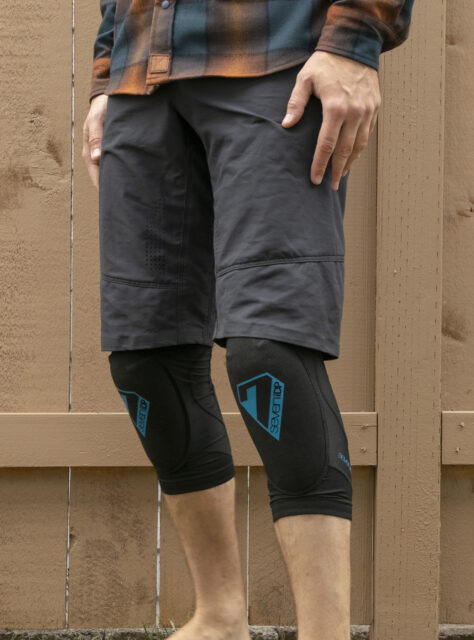
That said, the Transition would fit me better if the padded knee cup was a little bit wider and/or less deep. The sleeve portion of the pad fits great and feels true to size, but the cup feels like it ends up perched on top of my knee cap instead of wrapping cleanly around it and can shift side to side slightly as a result. I haven’t had any notable chaffing issues as a result, and it’s not like the pad is shifting far enough to leave my knee exposed or anything, but it could be more stable. The movement is more mildly annoying than it is a serious problem, and if I hadn’t also tried the 7iDP Sam Hill (up next) I’d probably be singing the praises of the Transition more strongly. They’re still really good knee pads, but I’ve just found an even better (at least for me) version in the Sam Hill (below).
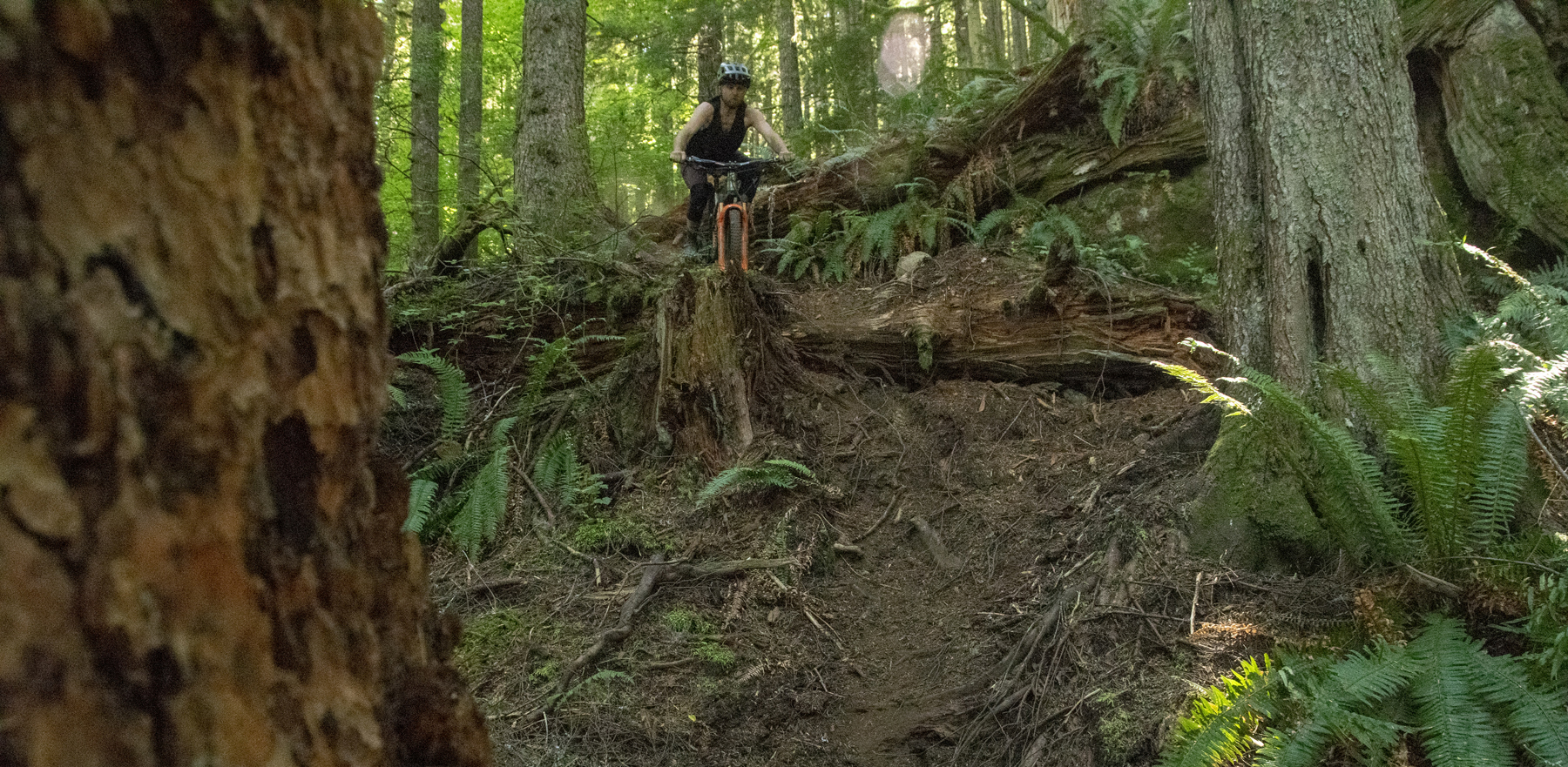
In terms of protection level, the Transition feels like a middle-of-the-road option for impacts to the center of the knee but doesn’t have much padding that wraps around the sides. Of course, that helps somewhat with breathability, and despite covering a larger-than-average portion of the leg, the Transition is fairly cool for its level of protection. It’s no substitute for a full-on DH pad, and there are lighter, more breathable options here, but the Transition is a nice middle-ground option that I’ve found to be comfortable to pedal in while still offering solid protection.
7iDP also offers a longer version of the Transition with more complete shin coverage, called the Transition Knee/Shin, which we haven’t tested but looks like essentially the same design, but extended most of the length of the shin.
MSRP: $89.99
Reviewer: David Golay (6’, 170 lb / 183 cm, 77.1 kg)
Size tested: Medium
Measured weight per pad: 168 g
Certification: CE EN 1621 Level 2
The 7iDP Sam Hill uses a sleeve system that’s very similar to that of the Transition (above), but with some extra padding sewn in around the removable foam knee cup, and though it uses the exact same knee cup insert as the Transition, that extra padding helps stabilize the knee cup and makes the Sam Hill pad far less prone to twisting side to side on my knees than the Transition.
And so while I like the Transition, that little tweak makes the Sam Hill a significant improvement in my book. The extra padding adds a tiny bit of weight and compromises breathability very slightly, but those differences are minor and the added stability of the knee cup more than makes up for it from a comfort perspective for me.
The added padding also makes the Sam Hill very slightly more protective than the Transition around the periphery of the knee area, but they’re not far off from each other in that (and most other) respects. They’re overall very similar designs.
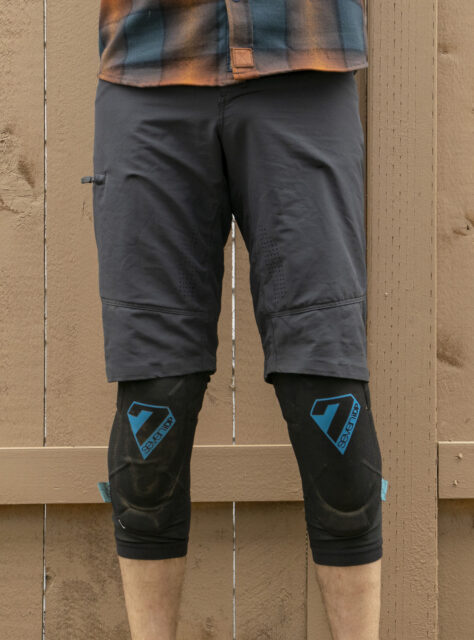
All of that has made the Sam Hill my go-to pad for longer days in the saddle where I’m still riding trails that are burly enough to merit a fairly protective knee pad. And in that role it’s great. I wore the Sam Hill pads on a 50+ mile, 11,000+ foot day recently and happily kept them on for the whole ride without issue. They’re quite impressive.

MSRP: $79.99
Reviewer: David Golay (6’, 170 lb / 183 cm, 77.1 kg)
Size tested: Medium
Measured weight per pad: 97 g
Certification: CE EN 1621 Level 1
Unsurprisingly, the 7iDP Sam Hill Lite is something like a slimmed-down version of the regular Sam Hill knee pad, but if anything that maybe undersells just how pared down the Sam Hill Lite is. Like the regular Sam Hill pad, the Lite version uses a compression sleeve with silicone grippers to hold the pad up and a removable (for cleaning) foam insert over the knee cap, but the Sam Hill Lite uses a shorter, more minimalist sleeve and a much thinner, more flexible, and lighter pad that breathes great and is super cool and comfortable but is also quite bare-bones (pun not intended) in its level of protection.
So I’ve been wearing the Sam Hill Lite on mellower rides and/or hotter days when I’m more inclined to roll the dice on the level of protection in exchange for something cooler and more breathable, and if you’ve got reasonable expectations for what that tradeoff entails, the Sam Hill Lite is a great option. They’re definitely light and breathable first-and-foremost, while still offering a little protection, but they’re the lightest, least-protective pad in this roundup by some margin.

Despite their lightweight construction, the Sam Hill Lite pads have held up fine to a couple of minor crashes and stayed put reasonably well during them, but they’re definitely more of a “take the edge off” kind of pad, rather than a highly protective one. Given how light and breathable they are, that tradeoff feels totally fair to me, but it’s proof that you can’t really have it all with these things — as in so many cases when it comes to outdoor gear, it’s much more a matter of knowing thyself and making the right compromises for your needs than there being any kind of universally applicable “best” anything.
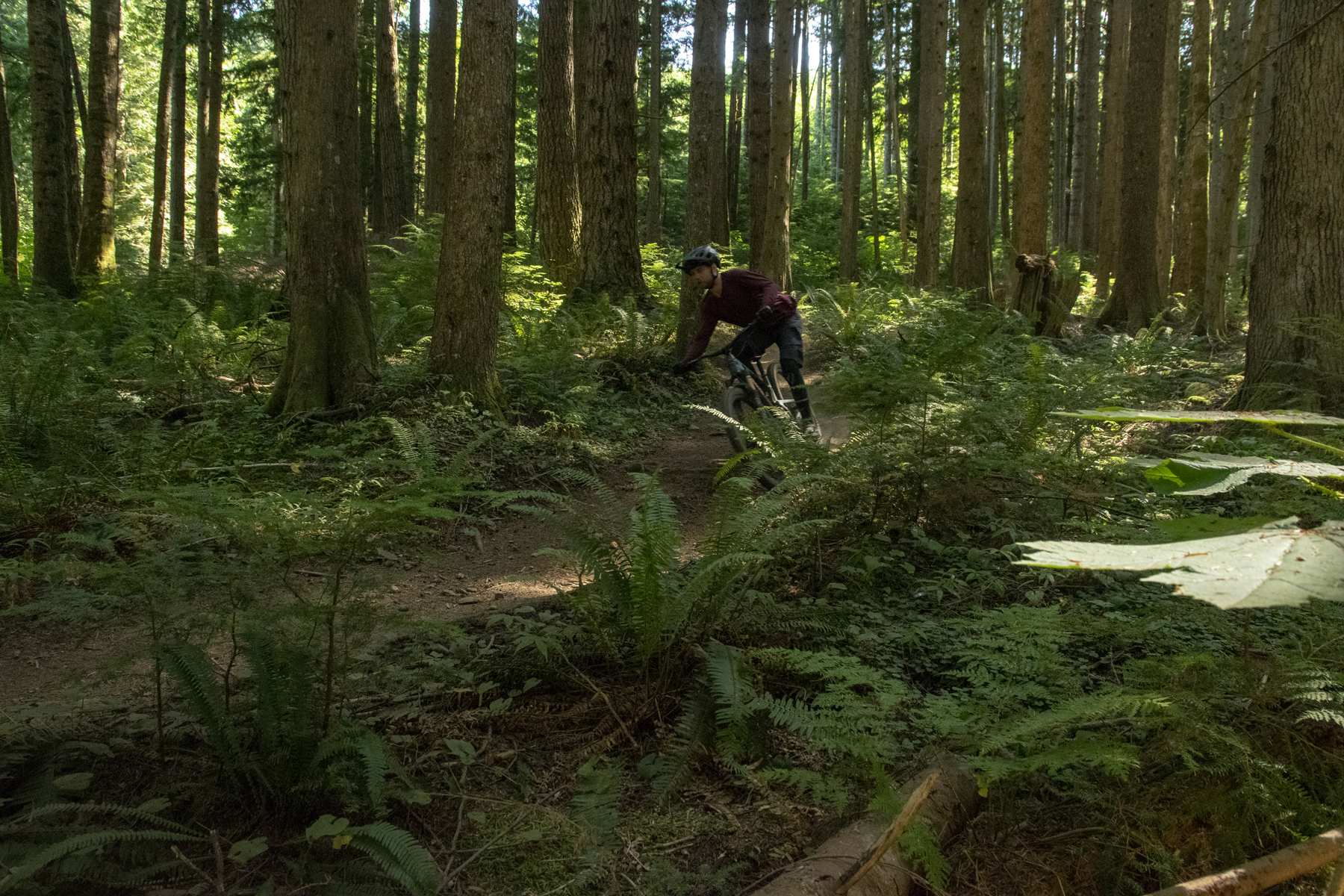
MSRP: $124.99
Reviewer: David Golay (6’, 170 lb / 183 cm, 77.1 kg)
Size tested: Medium
Measured weight per pad: 219 g
Certification: CE EN 1621 Level 2
At the other end of the 7iDP line is the Project knee pad, their burliest, most-protective offering. Think of it as something like a version of the Sam Hill but with thicker, tougher fabric comprising much of the sleeve, an extra semi-flexible plastic cap over the front of the knee, and a pair of symmetric velcro straps to further secure the pad mid-thigh.
As a result, the Project is both more secure and stable than the Sam Hill and also more protective, but is also warmer, less breathable, and not as comfortable to pedal in. I’ve still worn them on some longer days and haven’t had major chaffing issues or anything like that, but they’re on the warm side and definitely are more prone to rubbing than many of the thinner, more flexible pads here.
That said, the outer plastic cover is a nice feature, especially for people who are going to be wearing the Project with shorts, in rockier, harder terrain. Not only does it help dissipate impacts with sharp, pointy objects, but it also slides on rocks and hardpacked dirt much better than the cloth covers on many of the pads here. And I think 7iDP has done a nice job balancing all of that while still having the cover be somewhat flexible to conform with your knee as you pedal.


MSRP: $140.00 USD
Reviewer: Zack Henderson (6’, 160 lb / 183 cm, 72.6 kg)
Size tested: Medium
Stated weight per pad: 250 g
Certification: CE EU 2016/425
The Dakine Agent is a relatively heavy pad, but offers an inspiring level of protection and durability that should appeal to folks who favor protection and durability over pedaling performance.
The Agent is billed as a more protective option in Dakine’s lineup, and the very deep knee cup and extensive shin coverage reflect that intention. I found them to fit quite snug in my typical Medium size preference, but they did loosen up a bit over the first few rides. The DK Impact pad material is relatively flexible but firms up a bit when temperatures dip. I found articulation around the knee joint itself to be a bit lacking, and the pads didn’t conform as well to my knee as I would like when my leg was fully extended. The burly material on the front of the pad also does not breathe particularly well, but is impressively durable.
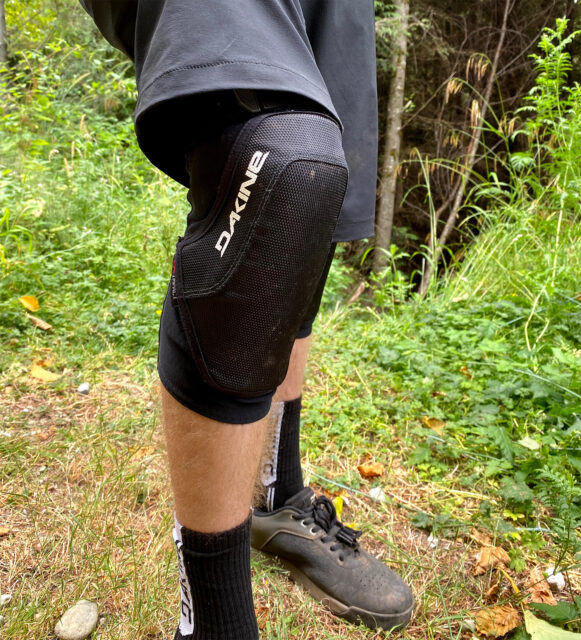
In my mind, these pads are in their element in the bike park, and they disappear nicely in a more aggressive, knees-bent stance while providing huge amounts of coverage. I had a couple of small crashes during the test period and the pads didn’t budge or show any signs of wear, and they give the impression that they could survive a couple of seasons of abuse without issue. Enduro-oriented riders who want something protective would likely be well served by these pads as well, provided that you don’t mind pulling them down around your ankles to prevent overly sweaty knees on the way up.
David: I’ve also tried the Agent a bit, and essentially agree with Zack’s assessment: the Agent pad is burly, protective, and does a good job staying put in crashes, but is hot and not very comfortable to pedal in. They also chafed the back of my knees pretty badly when I left them on the for the climbs. If you’re fine with sliding them down around your ankles to pedal, the Agent is worth considering, but I’d recommend that most folks who want a knee pad to actually pedal in look elsewhere.
MSRP: $109.99
Reviewer: Luke Koppa (5’8”, 155 lbs / 173 cm, 70 kg)
Size tested: S/M
Measured weight per pad: 200 g
Certification: CE EN 1621 Level 1
The MT500 Lite is one of Endura’s most protective knee pads, but it’s still built with pedaling in mind. Most of its protection comes from its fairly large and perforated D30 insert, which is pretty soft and pliable but will stiffen when subjected to an impact. The “Lite” version we tested covers that D30 insert with a stretch fabric and some mesh, with the goal of optimizing breathability; there’s also the MT500 Hard Shell pad, which features a more rugged build with a plastic cap over the pad to add protection and reduce friction when sliding during a fall.
I think the MT500 Lite hits a nice sweet spot of protection and pedaling comfort for a lot of folks. It’s quite breathable but offers notably more protection and coverage than the most minimal options, such as the 7iDP Sam Hill Lite. The MT500 Lite relies on a combination of silicone cuff grippers and upper and lower velcro straps to stay secure, and I’ve found them to be good at their job. I still can’t pedal for very long in it without some chafing, but I seem to be more sensitive to this than most other folks, and the MT500 Lite doesn’t move / shift as much during pedaling as the POC Oseus VPD or Scott Soldier 2. The MT500 Lite also features some PU foam padding on the inside and outside of the main pad, which I always appreciate when my bike and I are knocking around through a rock garden.
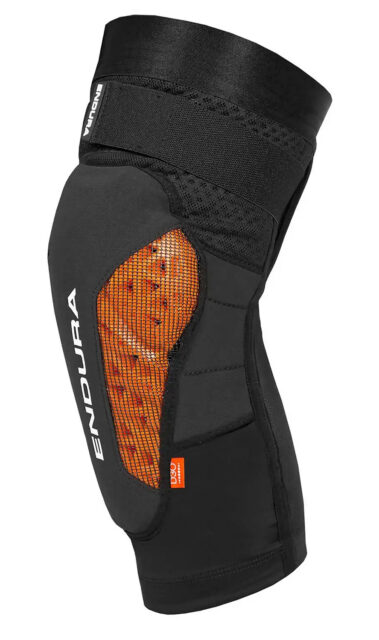
MSRP: $109.95 USD
Reviewer: Zack Henderson (6’, 160 lb / 183 cm, 72.6 kg)
Size tested: Medium
Measured weight per pad: 255 g
Certification: CE EN 1621 Level 2
The Ion K-Pact Zip is an unapologetically burly option that targets Enduro and Downhill riders, but the zipper feature adds impressive versatility for riders who often start with a long climb to get to a long continuous descent.
Ion uses a primary pad material called SAS-TEC for the knee cup, which is also surrounded by 3D foam on the sides of the knee. A zipper runs up the outside of each pad to allow easy removal without taking off your shoes, and upper and lower leg elastic straps keep things quite secure. I found the K-Pact Zips to fit slightly large for their stated Medium size, especially around the knee joint itself, but it hasn’t resulted in excessive shifting around in crashes. The fabric is quite plush and soft, and I’ve never had hot spots even from new.
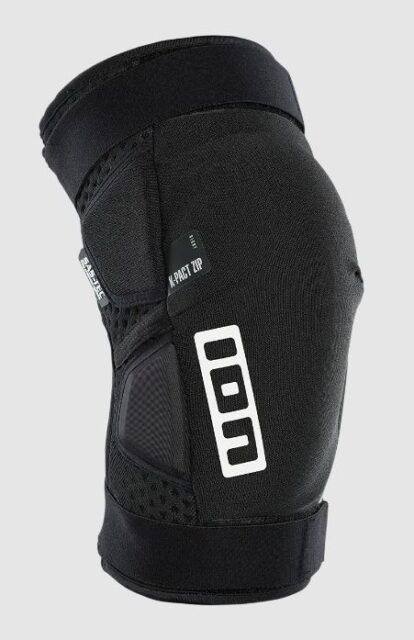
Unsurprisingly, these pads run quite hot, but the zip feature on these pads makes them an awesome option for riders who want a very protective pad without having to rock the pads-around-the-ankles look. I’ll typically strap the K-Pacts to my handlebars or hip pack using their own elastic straps for the climb, and then simply zip them on before a big descent. While that process is likely unappealing for riders who find themselves riding more rolling terrain or without a natural “transition point” between the climb and descent, this defining feature of the K-Pact Zip makes a ton of sense for a lot of us here in the Pacific Northwest who often grind long, mellow climbs or roads to get to the good stuff.
MSRP: $104.99
Reviewer: Luke Koppa (5’8”, 155 lbs / 173 cm, 70 kg)
Size tested: Medium
Measured weight per pad: 169 g
Certification: CE EN 1621 Level 1
I’d put Ion’s K-Lite pad in a similar class as the Endura MT500 Lite; the K-Lite is designed for Enduro racing and consequently straddles the line between pedal-oriented and protection-focused pads.
Like the MT500 Lite, the K-Lite pad uses both silicone grippers and dual velcro straps to dial in the fit, and I’ve found it to be reliably secure and comfortable. I still get some chafing during extended pedals, and the K-Lite runs a bit hotter than the MT500 Lite. Overall, though, the K-Lite seems adequately breathable and comfortable to be a solid choice for long climbs that get you to the top of fairly consequential descents, where a super minimal option like the Sam Hill Lite might seem a bit under-protective but a DH-specific model would be excessive.
The K-Lite features a large, flexible, perforated “K-L1 Lite” pad that handles most of the protection duties, but also includes multiple EVA foam pads on either side of the knee. It also covers the main pad with an abrasion-resistant material that bridges the gap between a typical fabric covering and a full hard-shell plastic. The main sleeve fabric is also reportedly reinforced with Aramid fibers, which should boost durability; while I haven’t crashed in it (yet), the K-Lite is holding up great so far.
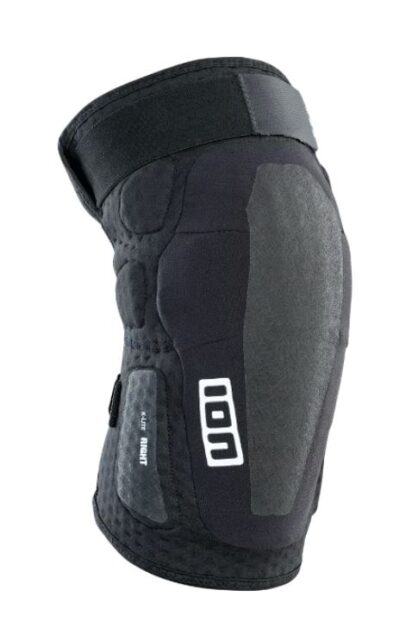
David: I’ve also spent some time in the K-Lite, and the thing that stood out most to me was how secure the fit felt, for what is a pad that’s meant to balance protection with pedaling comfort. I think part of that is that the K-Lite runs a hair on the smaller side of average for a Medium pad, and is just a bit tighter than many of the other options here on my legs; its strap system is also really well done and keeps the pads in place especially well, both when pedaling and when hitting the ground.

MSRP: $99.90 USD
Reviewer: Zack Henderson (6’, 160 lb / 183 cm, 72.6 kg)
Size tested: Medium
Measured weight per pad: 146 g
Certification: CE EN 1621 Level 1
The IXS Flow Evo+ is a very common sight on the trails here in the Pacific Northwest, and it’s an unobtrusive option that still offers better protection than some more lightweight pads aimed at the XC/trail crowd.
The Flow Evo+ pads breathe remarkably well compared to some other options, largely thanks to the stretchy AeroMesh material around the back of the knee. The knee cup offers relatively more minimalist coverage via a removable non-Newtonian pad made of what IXS calls Xmatter, and I’ve found the pad material to remain impressively pliable in colder weather. The pads don’t have any protection around the sides of the knee, favoring breathability over extensive coverage.
The price of their light weight and breathability is that the coverage is quite short — both in terms of how far the pads go up the thigh, as well as how far they extend down the shin. This does lead to some of the dreaded shorts gap where the hem of my shorts often sit above the upper cuff of the pad — unfashionable, but only an issue while seated and pedaling. The single calf strap is a somewhat unique approach to securing the pads, but it works incredibly well to keep the pads in place and goes unnoticed while riding. I wouldn’t choose the Flow Evo+ as my only pad, but they’re a great option for longer or lower consequence rides where they provide better-than-average protection for their weight and breathability.
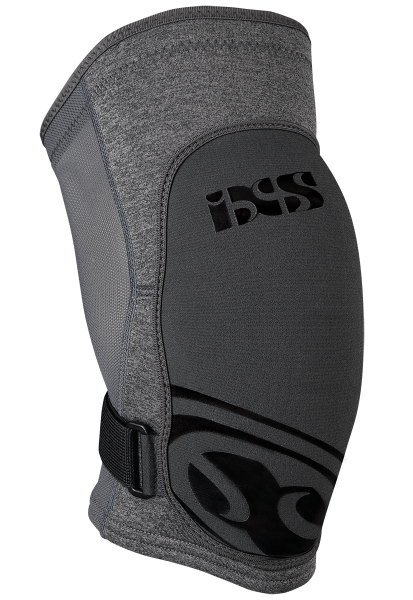
MSRP: $119.99
Reviewer: Luke Koppa (5’8”, 155 lbs / 173 cm, 70 kg)
Size tested: Medium
Measured weight per pad: 183 g
Certification: CE EN 1621 Level 1
Long story short: the AirFlex Hybrid is the only pad I’ve used that I can comfortably pedal in for a full day.
The AirFlex Hybrid blurs the lines between really minimal pads like the 7iDP Sam Hill Lite and more substantial Enduro pads like the Endura MT500 Lite and Ion K-Lite. The AirFlex Hybrid is primarily composed of a knit sleeve that feels more sock-like than Lycra-tight, which I think is part of why I don’t experience chafing issues with it. This pad still relies on silicone grippers to stay secure, but I think the combo of its sleeve being quite long and its fabric being highly stretchy (but not extremely tight) prevents the silicone from being pulled up and down my leg while pedaling. Despite the AirFlex Hybrid’s fabric being fairly thick, it’s still quite breathable and the back of the pad is mostly open, which adds to its ventilation.
The AirFlex Hybrid’s pad is a bit smaller than that of the Endura MT500 Lite and Ion K-Lite, but not by a big margin, and the AirFlex still offers just a bit of side padding. The AirFlex Hybrid’s main pad is covered with two small hard-shell pieces for reduced friction when sliding; while I’m much more confident in a traditional hard-shell pad for frequent crashes on hard terrain, it’s a nice touch that hasn’t impeded pedaling comfort at all in my experience.
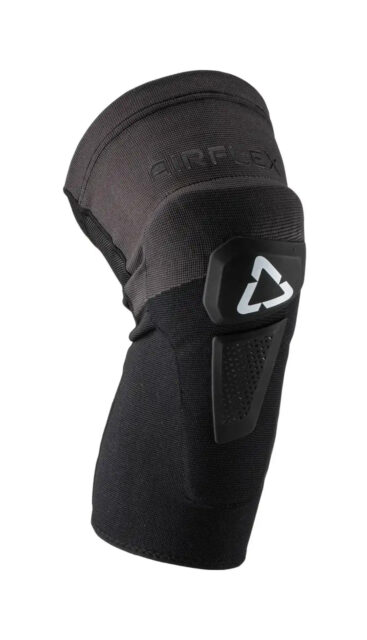
All in all, I’m a massive fan of the AirFlex Hybrid and it’s become my go-to pad for general trail riding. There are more protective options out there, and some of those might still work well for long days of pedaling for certain people. But especially if you’re like me and haven’t found a pad that you can pedal in without chafing but that still meets the EN1621-1, Level 1 standards, the AirFlex Hybrid is worth a close look.
David: Yep, the AirFlex Hybrid is remarkably comfortable to pedal in. The sock sleeve is on the thicker side but it’s super soft and breathes pretty well. The AirFlex Hybrid is on the lighter, less-protective end of the spectrum (though feels beefier that the 7iDP Sam Hill Lite), but if you’re okay making that tradeoff to get a super comfortable pad, they’re a great call.
MSRP: $150
Reviewer: David Golay (6’, 170 lb / 183 cm, 77.1 kg)
Size tested: Medium
Measured weight per pad: 185 g
Certification: CE EN 1621 Level 1
I’ve been a big fan of the POC Joint System VPD for a long time now, and they’re still one of my favorite options for a pad that’s fairly protective but still comfortable to pedal in all day. Like many of the options here, the Joint System VPD pads use a sleeve system without any additional straps to secure themselves, but (especially compared to the 7iDP Transition and Sam Hill, and Troy Lee Stage) use a much shorter elastic sleeve that doesn’t extend nearly as far up the thigh. Despite that, I’ve had no trouble with the silicone gripper at the top of the sleeve chaffing, even on very long rides, and with less of the leg covered by the sleeve, the Joint System VPD allows for better ventilation of the upper leg.
The tradeoff there is that the Joint System VPD isn’t the most secure pad out there, and can definitely get pulled down in some crashes, particularly on harder ground. The upper part of the gripper can also creep down slightly as you pedal, and while the actual pad has tended to stay put nicely on my legs, I do find myself needing to pull the upper part of the sleeve up my leg at the top of a lot of climbs.
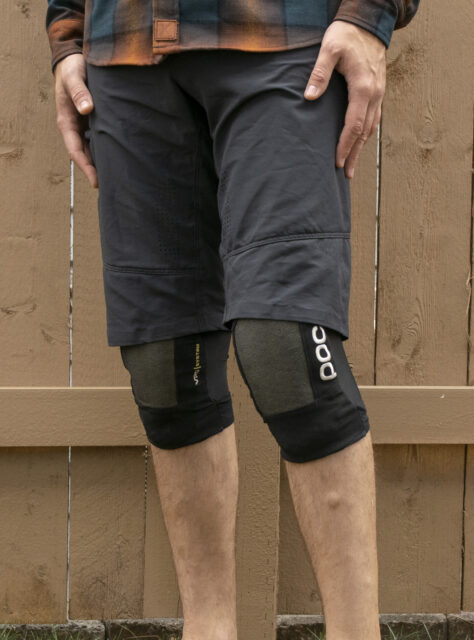
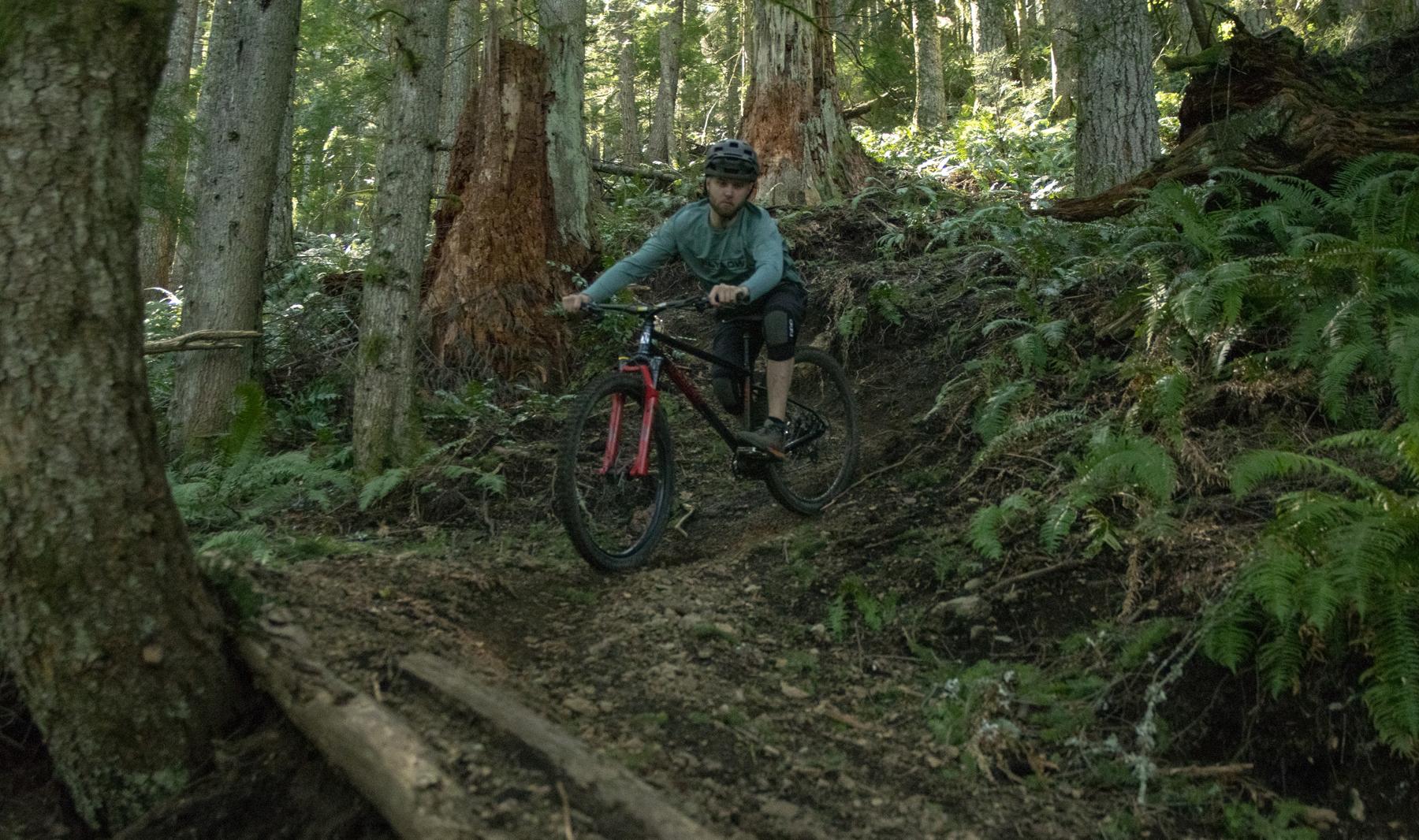
MSRP: $120
Reviewer: David Golay (6’, 170 lb / 183 cm, 77.1 kg)
Size tested: Medium
Measured weight per pad: 281 g
Certification: CE EN 1621 Level 2
The Joint VPD 2.0 has been in POC’s lineup for quite a while now, and it’s still a really good option for folks looking for a highly protective, secure pad for more gravity-oriented riding, and are willing to forgo some breathability and pedaling comfort to get there.
The Joint VPD 2.0 pads are pliable, fit great (at least for me), and do a nice job of conforming around my knees, but the strap arrangement does tend to pinch a little if I’m doing a lot of pedaling in them. They’re fine for shorter laps and are quite comfortable for more mechanized riding where I don’t need to do a ton of pedaling but aren’t particularly light or breathable, and if I’m going for a longer pedal I’d generally prefer something thinner, lighter, and cooler. That said, I haven’t had any major chaffing issues or anything like that in the Joint VPD 2.0; they just feel hot and somewhat restrictive.
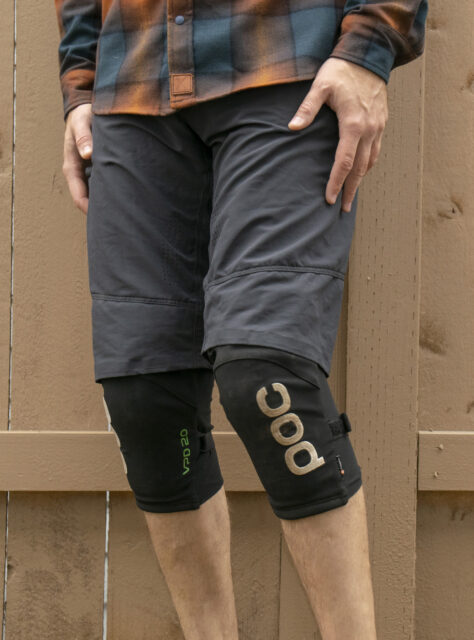
That’s not to say that they run small, though — they’re just a pad that’s meant to fit tightly, which serves them well when it comes to staying put in a crash. Generally speaking, I’d tend to recommend pads with a harder plastic cover (like the 7iDP Project) for folks who are especially worried about their pads catching and getting pulled down when they hit the ground, but the Joint VPD 2.0 has fared especially well for a cloth-covered pad for me in those situations, and they’ve also proven to be quite durable over multiple seasons of (mostly lift served) use. The Joint VPD 2.0 is also a clear step up in protection over the more pedal-friendly pads here, such as the 7iDP Transition and Sam Hill, or the Troy Lee Stage.
As per usual, it’s best to know thyself and think through how much protection you really need, and what you’re willing to trade off to get there. If you want a burly, secure pad for gravity-oriented riding and are okay with giving up some pedaling comfort to get there, the Joint VPD 2.0 is a very good option.
MSRP: $150
Reviewer: Luke Koppa (5’8”, 155 lbs / 173 cm, 70 kg)
Size tested: M
Measured weight per pad: 165 g
Certification: CE EN 1621 Level 2
Like POC’s Joint VPD 2.0 pad, their Oseus VPD pad is certified to the more rigorous EN1621-1, Level 2 standards, but the Oseus is designed to be a bit more pedal-friendly (it seems like POC markets the Oseus as more of an Enduro pad, whereas the Joint VPD 2.0 is more DH-specific).
In practice, the Oseus VPD is a very protective pad that I think will work for pedal-heavy rides for certain folks. It relies on a snug fit and silicone grippers to stay secure, and I think how well it works on the uphill will depend on fit and personal preferences. I apparently have sensitive skin, and I’ve only found one pad (Leatt AirFlex Hybrid) that doesn’t chafe the back of my knees while pedaling; like most pads, I can’t pedal in the Oseus VPD for very long before it gets uncomfortable, due to the silicone rubbing against my skin. That said, this pad has stayed plenty secure on long, rough descents, and its deep knee cup has not rubbed on my knee cap, despite the VPD material being fairly stiff, relative to most pedal-friendly pads I’ve used.

In addition to its fairly large and substantial-feeling main pad that covers the front of the knee, the Oseus VPD features a small piece of VPD padding on the inside of the knee, which I appreciate when I inevitably knock that area into the frame or seat of my bike.
Overall, the Oseus VPD is a very protective pad that also happens to be pretty light and fairly breathable. It’s become my go-to pad for bike park days, and I’ve also put in plenty of uphill miles with it, though that’s usually done with it at my ankles during the ascent.
David: I’ve gotten along well with a bunch of POC’s other pads, but the Oseus VPD really didn’t work for me. Like Luke, I found them to chafe pretty badly after more than a few minutes of pedaling. And while the Oseus VPD does breathe better, I’d still prefer even the VPD 2.0 (which is definitely a burlier, more protective pad) for all-day pedal duty for that reason.
MSRP: $80
Reviewer: Dylan Wood (5’10”, 158 lbs / 179 cm, 72 kg)
Size tested: M
Measured weight per pad: 170 g
Certification: n/a
POC’s Joint VPD Air Knee pad serves as a lighter, more pedal-friendly alternative to the more downhill-oriented Joint VPD 2.0 Knee. It’s also notably cheaper and has a more simple design than the Joint System VPD and Oseus VPD Knee pads. I like to wear knee pads going both up and down, whenever I am on the bike, and the Joint VPD Air has been great for that.
The Medium VPD Air fits my knees very well. Initially, I was worried that they’d be too big for my relatively skinny legs (my thigh circumference is 41 cm measured at 10 cm above my kneecap, and my calf circumference is 34.5 cm, putting me between POC’s S and M sizes), especially given that I’ve preferred size Small POC knee pads in the past. But, I found that the VPD Air stays in place nicely on my knees, all while feeling very comfortable and nonrestrictive. The VPD Air features an adjustable elastic strap with velcro fastening over the lower thigh, as well as two anti-slip neoprene strips at the top and bottom of the pad.
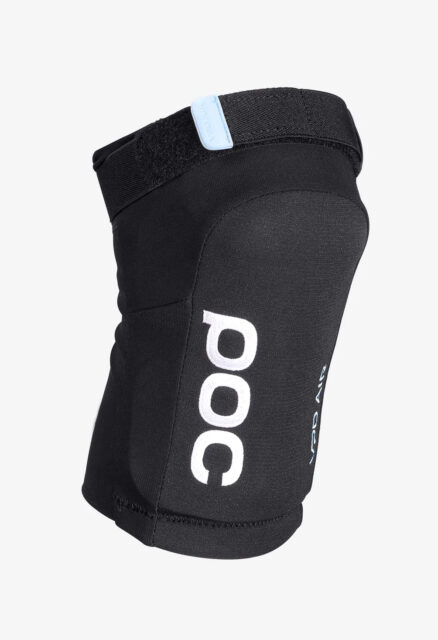
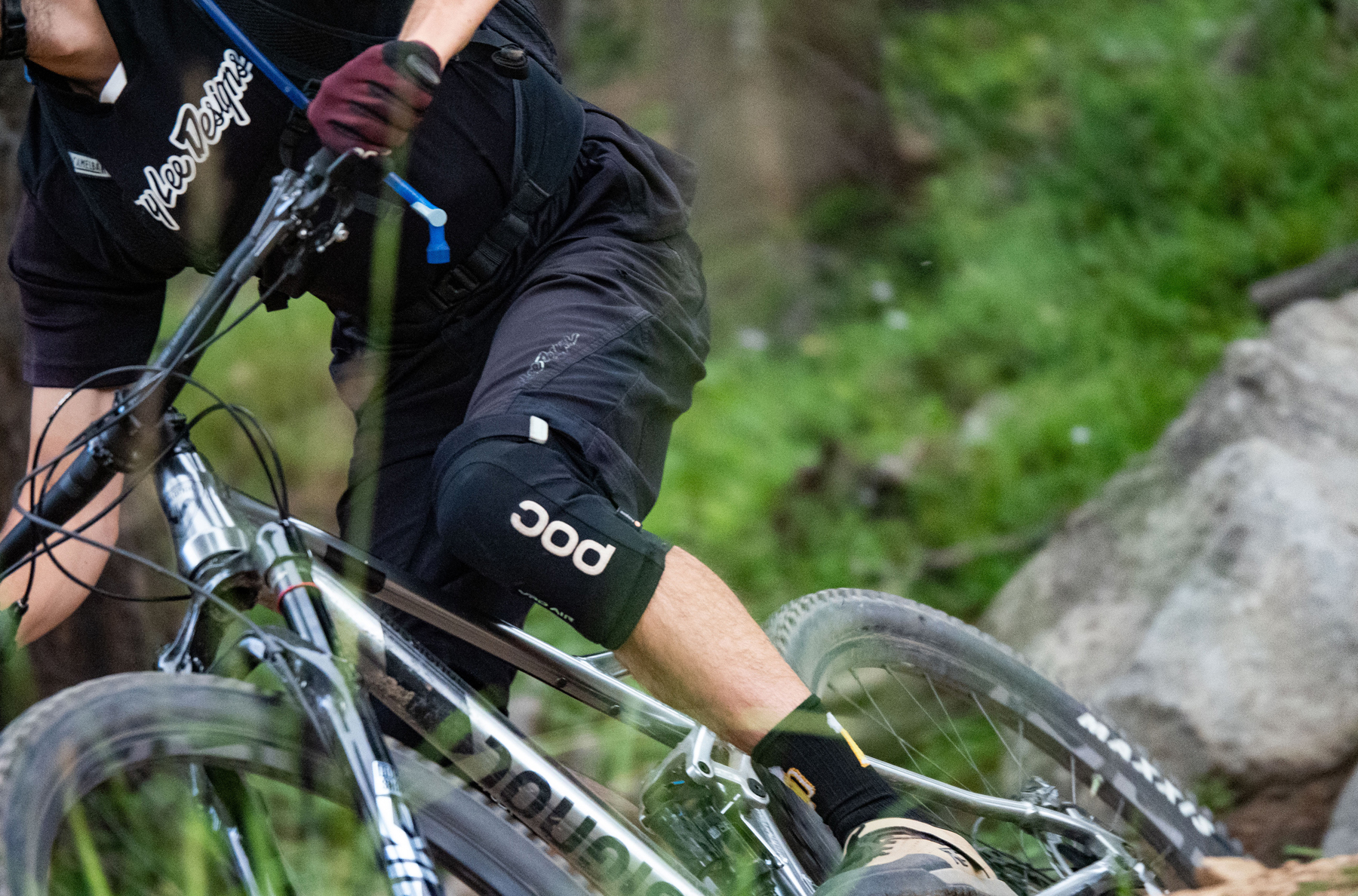
The VPD Air offers pretty nice protection on the way down, given how comfortable and pedal-friendly it is. It uses a single layer of POC’s VPD Air padding over the knee, which is very pliable, but stiffens on impact. This VPD Air padding also extends down the outside of the knees, and slightly further down inside the knees. I found this padding on the inside of the knees super helpful for protecting my knees against impacts from my frame and saddle, which happens to me often.
Luckily, I haven’t had many severe crashes in the season and a half that I’ve been using the VPD air, but after some smaller spills as well as a couple of bigger crashes, I’ve always come out of them with totally unscathed knees. The “reinforced stretch fabric” doesn’t seem quite as durable as the outer fabric of POC’s VPD System Knee pad, and might not withstand high-speed, sliding crashes as well.
So, if you value a good mix of protection and comfort both uphill and downhill, the VPD Air is certainly worth considering. There are options out there that offer a bit more protection, such as the VPD 2.0, but the VPD Air is a well-balanced knee pad that doesn’t break the bank.
MSRP: $79.99
Reviewer: Luke Koppa (5’8”, 155 lbs / 173 cm, 70 kg)
Size tested: M
Certification: CE EN 1621 Level 1
Scott’s Soldier 2 offers Level 1 protection in a highly breathable, minimal, and fairly affordable package.
The Soldier 2 is quite simple in terms of construction, with a single, fairly large D30 pad, very thin and breathable sleeve, and silicone grippers at both openings. All of this makes it pretty appealing for hot days of pedaling, though I think its comfort is more dependant on fit than many of the pads here. Personally, the Soldier 2 doesn’t interface super well with my legs; its silicone grippers rub the back of me knees when I’m in the saddle, and I’ve had some issues with it sliding down over the course of long, rough descents (particulary when it’s hot and my legs are sweaty). I think some people might not experience either of these issues, but for me, the Soldier 2 didn’t work as well on the up and/or down as the other pads I reviewed. (Like all the pads here, we reviewed the Soldier 2 in the size recommended by the brand’s size chart.)
If it fits you well, though, the Soldier 2 is a solid alternative to the Endura MT500 Lite and Ion K-Lite if you don’t need side protection or the adjustability of straps and instead want something more breathable.
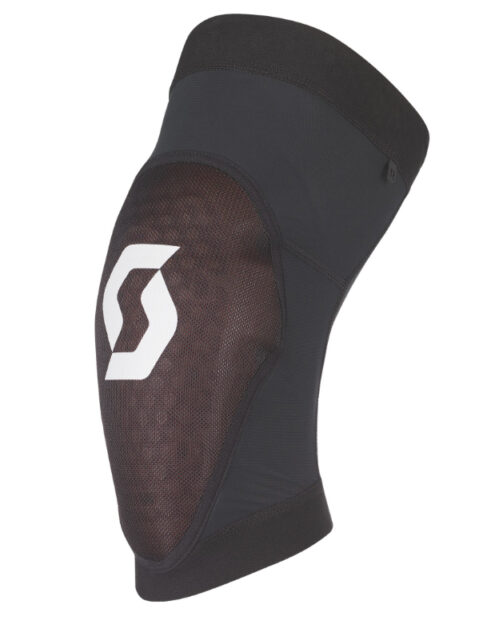
MSRP: $89
Reviewer: David Golay (6’, 170 lb / 183 cm, 77.1 kg)
Size tested: M/L
Measured weight per pad: 158 g
Certification: CE EN 1621 Level 1
The Troy Lee Stage is something like a slightly thinner, more breathable version of the 7iDP Transition (they’re still much closer to the Transition than the Sam Hill Lite) in that the Stage uses a similar sleeve design that extends far up the thigh, and it’s meant to be a middle-ground pad that’s reasonably protective while still being comfortable to pedal in. The Stage uses a D3O non-Newtonian insert for the padding, which is heavily perforated for ventilation, but is sewn directly into the sleeve that houses it, in contrast to the removable inserts in the various 7iDP pads, above.
The sleeve portion of the Stage doesn’t extend quite as far up the thigh as that of the 7iDP Transition or Sam Hill, but it’s still on the longer side and successfully moves the silicone gripper high enough up my leg to avoid any issues with chaffing or the pads slipping down as I pedal. It’s also notably thinner and more breathable than the sleeve used in the Transition, for better and worse. The sizing of the Stage also feels pretty true to their M/L label — I typically wear a Medium in most pads, and while the M/L still definitely feels like the right size for me, they’re a little looser fitting than most true Mediums.
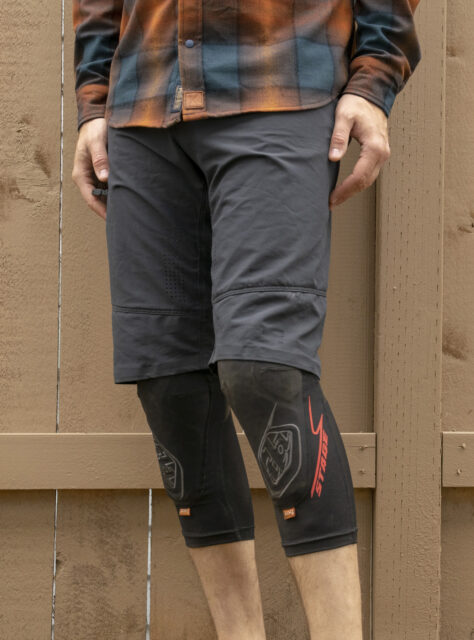
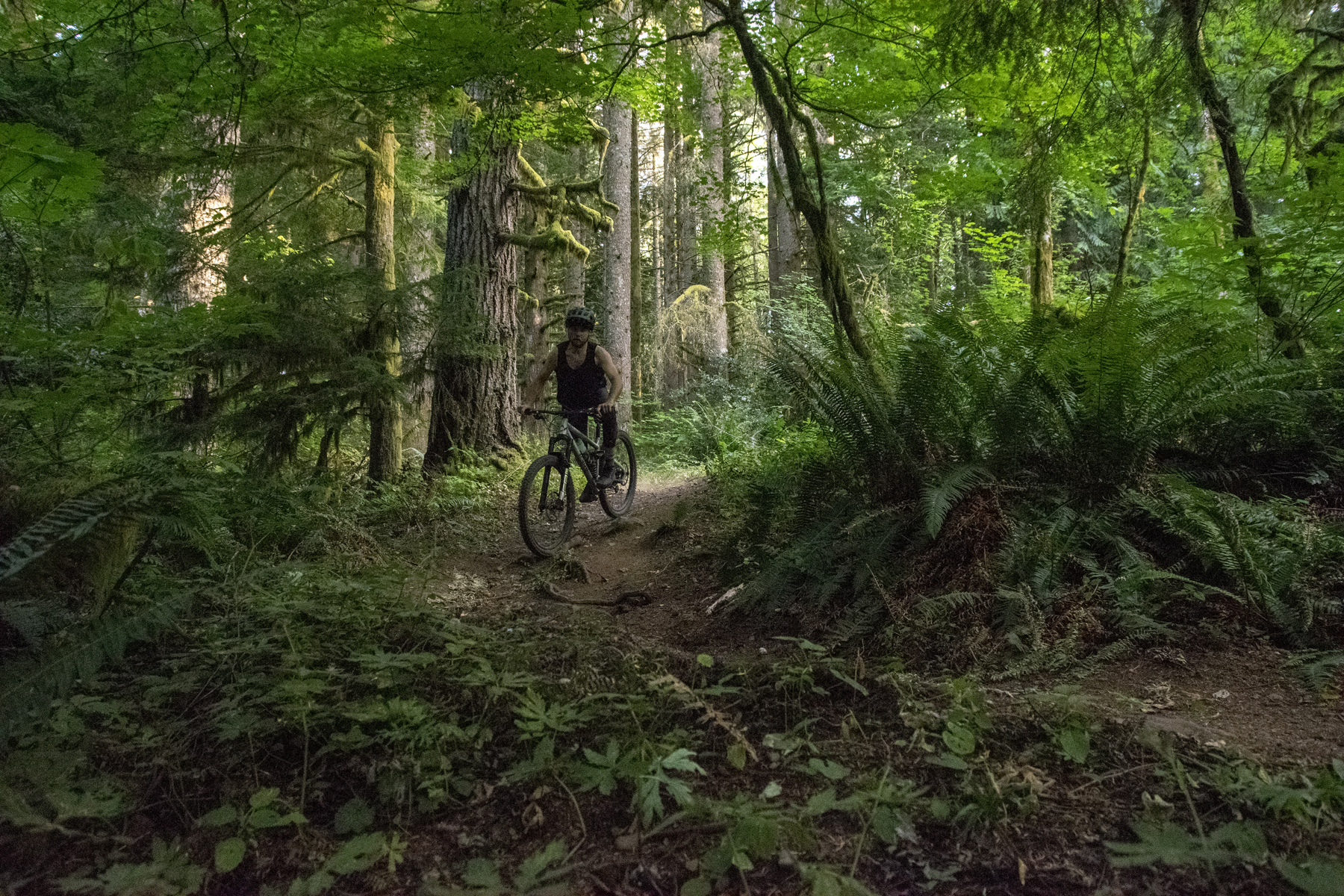
That’s too bad, because I found the Stage to be impressively comfortable and breathe super well. Maybe a little too well, since the lighter fabrics didn’t hold up to hitting the ground very well. I’d love to see Troy Lee make a slightly burlier version, because the fit of the Stage is absolutely dialed (for me) and the design shows a ton of promise. The flimsy mesh sleeve just let me down.



I own several of the knee pads mentioned here and a few others that aren’t (I have a slight problem…). My current rotation off all the knee pads I’ve had is 7idp Sam Hill for bike park/shuttle/burly days, Rapha Kneepads (so comfortable!) for most pedal days, and occasionally the Leatt airflex pro (my prior favorite before the Raphas) for the few times I want just a touch more protection than the Raphas but less than the Sam Hills. I own the 7idp Projects and never got along well with them and honestly find the Sam Hill just as protective but significantly more comfortable. The projects are loaned out to friends when needed now. I also own a set of the TLD stage and have been similarly disappointed in them, they bunch up terribly at the back of my leg and the coverage isn’t super great.
I’ve never read a negative review of the Sam Hills, but I own them and they have a number of glaring design defects that mean they do not absorb adequate shock on impact, & cannot be pedaled for more than 45 mins without removing skin from my knees. Here are their tragic flaws: 1) Pad material: the SAS-Tech pad is far harder than any other pad on the market, and even after “warming up” with body heat, it is less pliable, comfortable, and shock-absorbing, particularly in temps below 60F, than any of the dozens of competitors’ designs I’ve owned. Unlike D30, G-Form, or proprietary foams by Fox, Alpenstars, TLD, etc. the SAS-Tech transmits almost the full force of impact directly to your body: I’ve taken a high-speed blow to my knee on hardpack in the Sam Hills that resulted in a massive contusion that kept me off the bike for weeks. I’ve had similar falls in other pads that resulted in minor bruising / soreness, but still let me ride again the next day. 2) Shape: The pad’s excessively-concave shape results in “fangs” on the sides that dig in around my kneecaps. This forces the sleeve’s ill-placed seams into my knees, removing skin in less than 1hr of pedaling. 3) Seams: the seams for pad removal run directly across the center of the kneecap on the Sam Hills, guaranteeing maximum movement & friction with every pedalstroke. My Fox Enduro Pros have their pad-removal seam down at the bottom of the pad, where they never chafe. It’s a shame: the long sleeve of the Sam Hills does indeed feel great and stay put, and the “halo” of soft foam around the main pad inspires confidence, but the SAS-Tech pad might as well be made of wood, so I don’t even trust them for shuttling or park days.
Hey Mateo,
Thanks for the feedback. That just goes to show that personal fit trumps most other considerations when it comes to choosing knee pads, because the Sam Hills have genuinely been impressively comfortable for me to pedal in, without any of those chafing issues that you’ve experienced. It’s too bad that they haven’t worked for you, but that’s why we encouraged people to try things on before they buy at the top of the roundup. I can only comment on how the pads have worked for me, personally, but the Sam Hills have worked extremely well for a pedally knee pad on my legs. In my case, the concavity of the knee cup does a good job of keeping a bit of a gap in front of my knee cap so that nothing rubs of chafes there, but the edges transition smoothly into the sides of my knees so those haven’t dug in on my legs like you described either. I’m certainly not discounting your experience, just making clear that mine has been quite different.
I do absolutely agree that they’re only middle-of-the-road protective, and there are much burlier options in this roundup, the POC VPD 2.0 first and foremost. Given how well they’ve worked for me to pedal in, that strikes me as a fair tradeoff, but your mileage clearly may vary.
I’ve owned about half of the kneepads reviewed here, and agree with most of the assessments. The 2 big differences I found were:
* Sam Hills chafed me quite a lot at the top and bottom of the insert, which I attribute to the stiffness of the insert. They also gave me a huge bruise a couple times in crashes, and the sock/sleeve tore right above the padding in an OTB, resulting in a really nasty scrape.
* TLD Stages have held up quite well for me in multiple crashes, and haven’t moved. I think the cupped shape of the insert and fairly smooth face fabric helps a lot with that. No chafing even on long days (4000′ climbing / 6 hour rides). Eventually the silicon grippers do lose some stickiness. The silicon calve band did fall off after a lot of washing on my second pair. Somehow I only have 1 small hole in the rear mesh fabric, but I’d put it’s durability vs. pedal pins approximately on par with tissue paper.
* Leatt Airflex Hybrids are so close to being my wonder knee pad. The issue I run into with them is that the sleeve doesn’t go up very high on the thigh, and there isn’t enough silicon grippers on the top of it. It would probably be too warm if the sleeve went up mid thigh like the Stage, but the puny little triangular grippers struggled to hold onto my legs once they got good and sweaty. I’d love to see a revision with better grippers, and maybe the lower half of the insert extended down another inch or so, and maybe an extra half inch around the shin. That said, the guy I gave these to loves them, and continues to wear them despite accumulating a few rips on the backside.
I’m not sure why so many pads have a velcro strap right above the knee. Every pad I’ve ever tried with that design has it cut into my hamstrings while pedaling. On the Projects and IXS Triggers, those straps literally left bloody sores on the backside of my legs.
How does the Leatt Airflex Pro perform relative to the above pads?